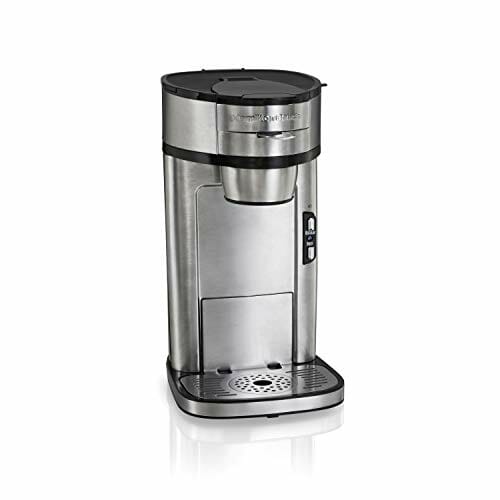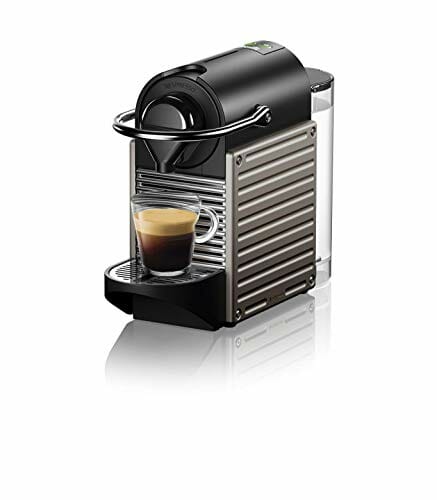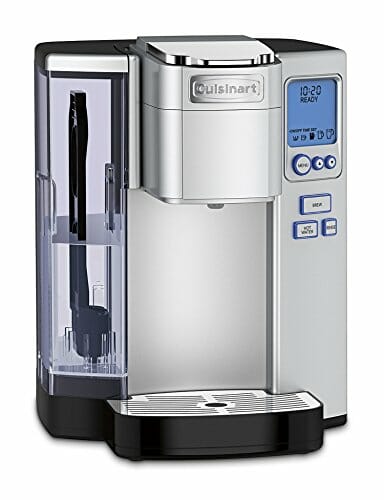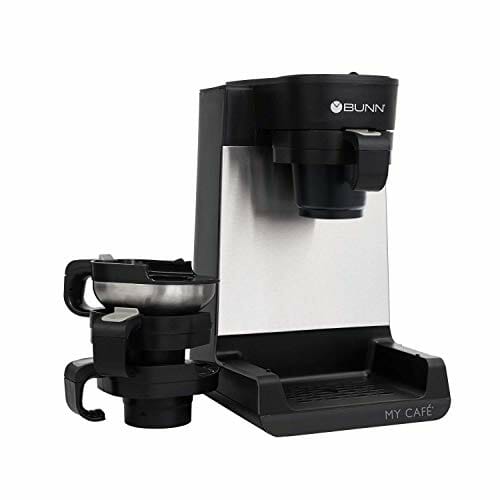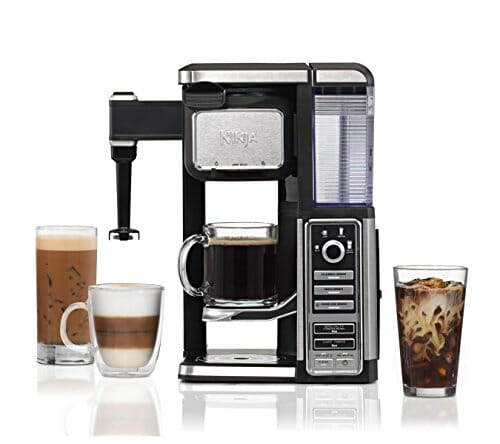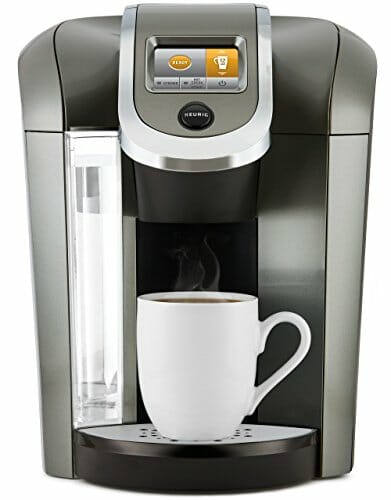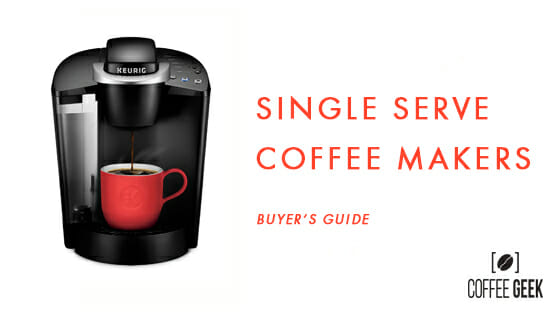
Single-serve brewers were born out of a necessity to overcome the office break room tragedy: A stale, overcooked pot of coffee.
Their popularity for use in the home solved many casual coffee lovers’ problems with brewing more coffee than they could drink in a sitting, too.
These brewing machines are now fully integrated into the drip coffee maker market.
Traditionalists and boutique-favoring baristas may still turn their nose up at certain aspects, but we’re about to show you what to love — and what to hate — about our top picks.
Read on for our full review to see how our picks may be one of the Best Single Serve Coffee Makers for you.
- Our Top Rated Choice: Keurig K55 K-Cup
- 7 Best Single Cup Coffee Makers: How They Compare
- Why choose a single serving coffee maker?
- What to know before you buy Single Brew Coffee Maker?
- Our Best Single Serve Coffee Makers: How They Perform
- Frequently Asked Questions About Single-Serve Coffee Makers
- Editors Choice: Keurig K55 K-Cup
Our Top Rated Choice: Keurig K55 K-Cup
Keurig set the standard for the modern-day single-serve brewing device.
The K55, also known as the K-Classic, is one of its bestselling models and that’s because it offers just enough without going overboard.
With three brew variations and a 48-ounce water tank, it’s built to satisfy the most common one-cup preferences of the average coffee-drinker.
Consumers who love this coffee maker note it’s quieter than the brand’s first offerings to the market, which means you’re getting a fast brew cycle without an excessive amount of gurgling and sputtering.
Also, because this model is part of the Keurig Classic series, it’s compatible not only with the K-Cup pre-packaged and refillable pods, it can also handle off-brand pods of the same size and shape.
While this model doesn’t have all the bells and whistles some single-serve machines offer, we think it hits all the marks for a reliable brewer with consistent results at an affordable price.
Down below, we share our thoughts about how others that cost less or offer more compare and perform.
7 Best Single Cup Coffee Makers: How They Compare
| Coffee Maker | Product | Features | Price |
|---|---|---|---|
Top Pick 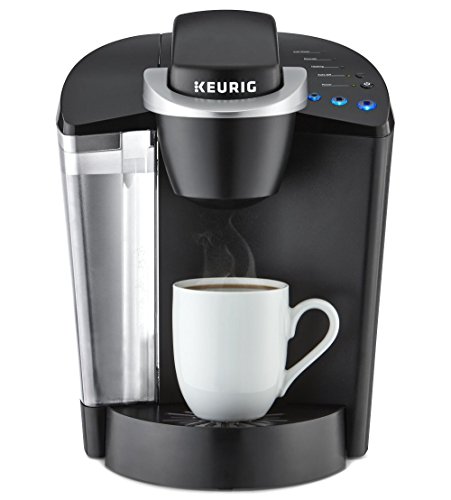 |
| CHECK PRICE | |
Budget Pick  |
| CHECK PRICE | |
Popular Pick  |
| CHECK PRICE | |
Most Pod Compatible  |
| CHECK PRICE | |
Easiest To Clean  |
| CHECK PRICE | |
Ideal For Milk Coffee Lovers  |
| CHECK PRICE | |
Best For Programming  |
| CHECK PRICE |
Why choose a single serving coffee maker?
First and foremost, you need a single serve brewer if you’ve ever found yourself reaching for a second cup of coffee and the taste made your mouth pucker with sour or bitter notes.
Even drip brew machines with small batch settings can’t really handle the average single serving of coffee without overshooting the mark and leaving a second cup to turn rancid in the pot.
1. Convenience These machines are as straightforward as it gets for a brewing device.
Whether you’re using a pre-packaged pod or a refillable capsule, you’re brewing straight into the cup of your choice without fiddling with carafe lids or warming plates.
2. Speed Most single-serve brewers worth their weight in expertly roasted grounds will have a cup of coffee ready in under a minute.
The exact serving size and power setting you choose may increase the exact time it takes to fill the cup, but not by much longer than a minute. Anybody who knows how quickly a work break goes by can appreciate that.
3. Quality The volatile oils that give coffee its flavor profile are so incredibly sensitive to heat and light that they begin to degrade quickly when exposed to either.
Even drip-brew machines with warming plates note in their manuals that coffee shouldn’t be left to sit for longer than 20-30 minutes.
If you’re brewing straight into your cup, you’ll always have the freshest flavor. These brewers aren’t without their detractors, however, and many critics make valid points.
Check out the next section for what you should consider before you buy one of these machines, then read our answers to frequently asked questions later on.
What to know before you buy Single Brew Coffee Maker?
Most enthusiasts would benefit from a single serve programmable brewing device option in their home, especially if they need a convenient and quick brewing cycle.
As this trend has evolved, certain issues have been brought to the attention of the industry — and brands have answered them in a variety of ways.
We’ll discuss some of those common complaints and what to look for when it comes to avoiding these issues, then we’ll break down how each model compares and where they may exceed or fall short of these expectations.
1. Limited options for versatility
The chief criticism of single-serve machines may not seem to make much sense given that it’s casting the biggest benefit as a flaw.
That being the brewers make one cup and one cup only of coffee at a time.
In circumstances where a few or more people each want a cup of coffee, like on a work break or as an after-dinner holiday treat, the one-cup-at-time pace can prove frustrating.
Add to that the fact that certain models don’t handle making several successive cups of coffee at once and could begin to splutter or overheat.
If you anticipate the need to make more than a cup at a time, or several cups in a row, will arise frequently in your circumstances, you may need to look for a single serve machine with a range of brewing options.
2. Built-in filtration adds cost
While the addition of a built-in charcoal filtration system is a great idea and we think it saves a good deal of effort and brewing time, it can be an added cost that some people may not welcome.
Some brands may use proprietary filters which lock consumers into only purchasing that brand’s item at the price they’ve established, leaving the consumer without the option to find a cheaper filter.
Filter inserts typically aren’t that expensive in either case, but it does become one more component to keep track of and change out when necessary.
The average coffee-drinker may only need to change it out every few months, but heavier use will need more frequent changes.
Many brands include a few filters with new machine purchases, though. to help them get started.
3. Water temperature may be inconsistent
A common complaint about some of the earlier models of single-serve brewers had to do with whether or not the water was actually hot enough to properly extract a cup of coffee.
Proper extraction occurs between 195-205 degrees Fahrenheit (90-96 degrees Celsius).
The closer the water gets to the hotter side of the range, the better, but manufacturers may keep their internal thermometers calibrated for the lower side as a safety precaution.
Others allow the consumer to set the optimal temperature for their brewer, so if you want more control, consider machines with settings like these.
4. Brew strength options make a difference
Some critics dislike a one-size-fits-all approach to coffee-making and we hear them loud and clear.
Several brands now include an option to make a bolder cup of coffee for anyone who may have found themselves disappointed by the regular power setting.
Single serve machines don’t allow for many variations when it comes to the amount of coffee you use in each brew. For consumers who equate using more grounds per cup with a bolder flavor, this seems like a setback, but that’s not always the case.
We talk more about how a brew power selection works in our frequently asked questions section down below.
5. Hit or miss programmable features
Due to the straightforward simplicity that drives the design behind many single-serve machines, there are quite a few that don’t include the usual programmable settings that became popular for conventional drip-brew makers.
This is even more apparent with coffee makers designed for one person.
Given how quickly they brew and how easy they are to use, many brands may have thought this an unnecessary and costly addition. Still, many consumers prefer to wake up to the smell of their coffee brewing.
We’ve included a few models with programmable features in our review, so if that’s the kind of feature that makes or breaks a deal for you, we’ve got you covered.
Take a look at our comparison chart above to see which models offer it and then read through our list of pros and cons for each. Below we go into detail on each single-serve model.
Our Best Single Serve Coffee Makers: How They Perform
Take a look through our favorite single-serve coffee makers to see what we think about what works, and what doesn’t, for each model.
Budget Pick: Hamilton Beach 49981A
As one of the most affordable options on our list, we like this Hamilton Beach brewing device for its simplicity and size.
The slim build is an easy fit for small kitchens and it’s easy to use your favorite brand of ground coffee or grind it fresh for each brew.
The chrome finish offers a thoroughly modern look that matches with a variety of decor themes. If you’re looking for a bigger budget and a multi-cup machine, I recommend reading this Hamiliton Beach Flexbrew article.
PROS
- Stainless steel body is durable and sleek
- Can be used with or without a paper filter
- Slimmer and shorter than many other one-cup brewers
CONS
- Prone to overflow brew basket with fine ground coffee
- Reusable filter still allows some sediment into the cup
- The reservoir can impart a plastic taste at times
Nespresso Pixie – Best Single Serve Espresso Maker
Somewhere between a one-cup brewer and an at-home espresso machine, the Nespresso Pixie espresso maker combines the best of both worlds and comes out on top with this model.
True to its name, it doesn’t take up much space. It manages to look retro and modern all at once with its unique design.
In terms of functionality, the Pixie brews a very specific kind of cup for a similarly specific palate.
PROS
- Brews espresso-style strength and sizes
- Capsules make it easy to get the right measurement
- Auto-off saves energy and time
CONS
- Two size selections are smaller portions than the average cup of coffee
- Cannot be used with off-brand capsules or coffee
- Caters only to consumers who prefer espresso strength coffee
Cuisinart SS-10 Coffee Machine
This brand’s one-cup model has a lot of desirable and versatile features, which makes it a great option for homes and offices where the coffee-drinkers need a variety of choices to suit their collective preferences.
With its large, filtered water reservoir, it can brew cup after cup before it needs a refill.
The programmable display is also a handy addition for anyone who wants to set their coffee up for automatic brewing.
PROS
- One-touch hot water dispensing for tea and instant foods
- Temperature control setting for hotter water
- Backlit LCD display and buttons
CONS
- May require experimentation to understand all the features
- Mostly plastic build doesn’t feel as durable as other brands
- Will not brew if LCD display malfunctions
BUNN MCU Coffee Maker
The Bunn-O-Matic Corporation has built a reputation on innovating the coffee industry, so it makes sense that they have their own single-serve model on the market.
While they’re better known for reliable, straightforward machines without a lot of feature add-ons, this one-cup brewer still manages to squeeze a few extras in.
The multi-drawer system gives you a lot of options when it comes to brewing pods, fresh coffee or even tea.
PROS
- Removable drip tray for use with larger mugs
- Pulse brew setting for a stronger taste
- Tea bags and soft pods can be used in the brew basket
CONS
- Small reservoir inconvenient for brewing more than a cup at a time
- Brew drawers have to be switched out for different brew types
- Difficult to measure serving portions
Ninja CF110 Coffee Maker
There’s a lot of subtle but effective technology behind Ninja’s coffee brewing systems. That’s true for their single-serve model, too.
Not only do they make choosing a brewing size as easy as tuning a dial to your preferred amount, but they also give you a few strength control options across every choice.
The “Rich Brew” setting works a lot like the “Bold” setting of other brands, but Ninja also gives you the choice for even more concentrated brewing selections in a 4-ounce and 8-ounce serving.
PROS
- The large variety of brew selections and strength options
- Preheated water reservoir delivers optimal temperature for brewing
- Milk frother for cafe-style service
CONS
- Bulky build compared to other one-cup brewers
- Internal components can suffer if the machine is moved around a lot
- Might be too detail-oriented for casual coffee-drinkers
Keurig K575 Coffee Maker
This Keurig Plus Series model offers one of the brand’s largest water reservoirs, which means you have the option to brew several cups or a full carafe before you need to think about refilling it.
This is a great option for busy homes or offices with a high demand for coffee.
If you love the simplicity of our top choice, the K55, but need a few more options and features, this is a great upgrade.
PROS
- The wide range of brew variations includes K-Mug and K-Carafe options
- Auto-shutoff feature
- Can be programmed to auto-brew
CONS
- No temperature control for hot water
- Only works with K-Cup 2.0 pre-packaged or refillable pods
- Loud brewing cycles
Frequently Asked Questions About Single-Serve Coffee Makers
We want you to know everything you need to in order to make the most suitable choice for your next purchase.
Read through our answers to these frequently asked questions, then check back through our comparison chart and review to see which single serve brewing device fits your needs best.
1. Do single serve machines brew faster than traditional drip brewers?
One of the biggest selling points of a one-cup machine is how quickly it delivers a cup of coffee when compared to more traditional brewing cycles.
That’s because the internal components are all specifically calibrated to brew a single serving rather than a full pot of coffee. Coffee makers that offer a brew strength setting may slow the timing of the brew cycle down to extract a bolder flavor, but it will still brew faster than the average pot of coffee.
2. What’s the difference between a single serve brewer and an espresso machine?
While there are some similarities in the science behind a one-cup device and an espresso machine, they are not the same thing.
An espresso machine uses pressure to force steam through finely ground and tightly packed coffee to extract a thick, boldly flavored concentrate.
Single serve machines works more like traditional coffee brewers, which means they pour hot water through a medium coarse grind of coffee slowly to extract a milder, less concentrated cup.
3. Can other hot beverages or instant foods be prepared with these models?
Many single serve drip coffee makers recognize the benefit of giving consumers some options for brewing tea, hot cocoa or dispensing hot water for instant food like oatmeal or noodles.
If you choose a model that does not specifically state it can be used for these options, it’s better to err on the side of caution and assume it’s not compatible for those purposes.
Some brewing chambers may not function properly if left empty or hold anything other than the appropriate size of coffee grounds.
4. Are single-use pods and capsules recyclable?
Brands that offer pre-packaged pods and capsules have been criticized for the potential environmental impact of non-recyclable materials.
Check the labeling of any single-use pods if this is an important factor for you. Even pods made of recyclable materials will need to be cleaned properly before they can be recycled.
5. Do single serve Machines need to be descaled or delimed?
Yes, every brewer should go through a descaling or deliming process to clear out any mineral deposits from the water used for brewing. It also helps to clear the brewing chamber of any coffee residue.
The exact process for this, plus how frequently it needs to be done, will be different for every one-cup brewing device.
If you’re using your machine more frequently than the average consumer, you may need to clean it more often than the suggested timeframe.
6. How does a brew strength setting work?
While it seems like common sense to just add more coffee grounds and brew with the same amount of water to get a stronger flavor, this is actually a terrible way to get a bolder tasting cup of coffee.
Proper extraction depends on the appropriate ratio between coffee grounds and the volume of water being used, plus the time these two spend mingling and marinating together.
Machines that offer a brew strength setting simply slow down the dispensing process either by pulsing the water through the grounds or releasing it over a longer period of time.
7. What type of coffee does a single serve coffee maker brew best?
Finely ground coffee, like the kind an espresso machine uses, may cause many single-serve brew baskets to overflow or clog.
If you’re grinding beans fresh before every brew, try to get a uniform size that looks like coarse sea salt.
Coarser grounds, like the kind used for press pots and some pour-over devices, may not extract properly even if they don’t seem to clog or disrupt the brewing process of a one-cup machine.
As long as the grind size is right, any light, medium or dark roast can be brewed with good results.
8. What size grind works for single serve coffee makers?
Because these single-serve coffee brewers perform much like the traditional coffee makers, you should be using a medium coarse grind with them.
Pre-ground coffee beans for automatic single serve coffee machines should work if you’re using a model that allows for reusable pods or loose grounds.
If you’re grinding your own beans, keep an eye on the uniformity of size and avoid using anything that winds up too fine or you may experience spillage from the brewing chamber.
Editors Choice: Keurig K55 K-Cup
So there you have it! Keurig do set the standard for the modern-day single-serve brewing device.
The K55, also known as the K-Classic, is one of its bestselling models and that’s because it keeps it simple and reliable for any coffee enthusiast.
With all it’s features, brew variations and a 48-ounce water tank, it’s built to satisfy the most common one-cup preferences of the average coffee-drinker.
For more read the reviews here.


